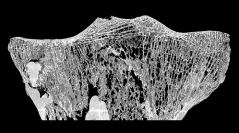

 Comptes Rendus Palevol
9 (6-7) - Pages 349-359
Comptes Rendus Palevol
9 (6-7) - Pages 349-359Within the limits imposed by a variety of developmental and rheological constraints, cortical bone adapts to biomechanical loads by partial alteration of its shape, mass and (micro)structure. As bone thickness variation locally reflects the nature, direction, frequency, and magnitude of such loads, some locomotion-related differences are expected in the structural organization of the primate tibial plateau. Here we summarize the results from the first microtomographic-based (SR-μCT) extensive analysis of the topographic variation of the cortico-trabecular complex underlying the adult tibial plateau in a number of primate taxa, including Homo. The goals of the study are: (i) to assess the relationships between habitual postural/locomotion-related joint loads and the structural signature recorded by the cortical shell of the articular plateau by comparing the evidence from a bipedally-trained (Sansuke) and a wild Macaca fuscata; (ii) to assess an “anthropic” (bipedal) pattern; (iii) to explore the possibility to perform similar quantitative analyses on fossil specimens.
Tibial plateau, Inner structure, Locomotor behaviour, Primates, Microtomography, Fossil record